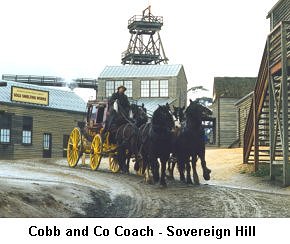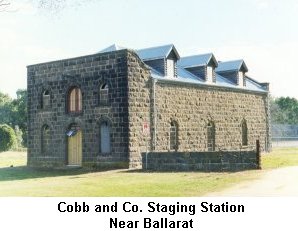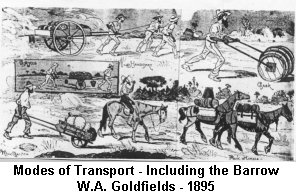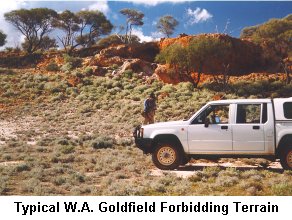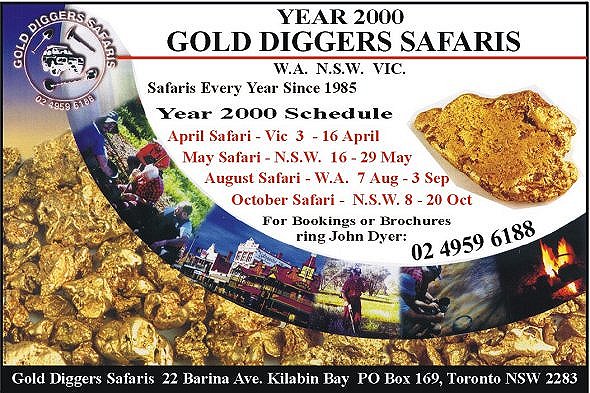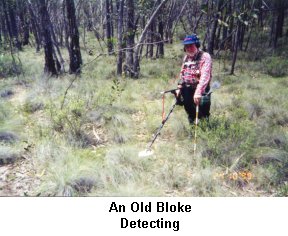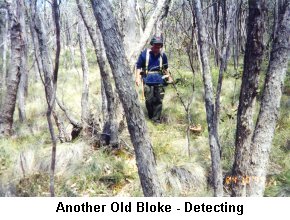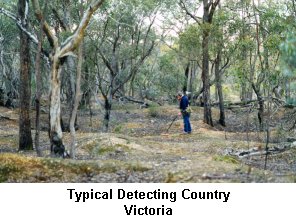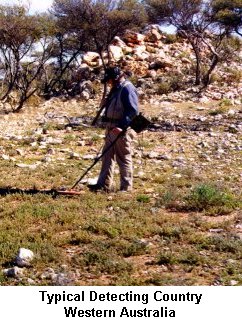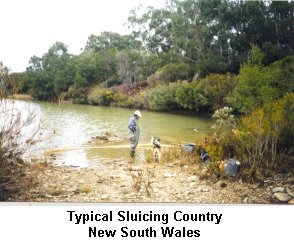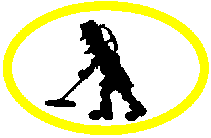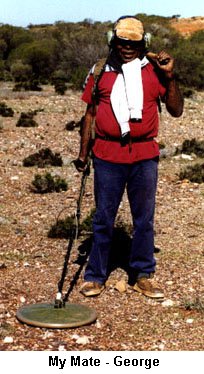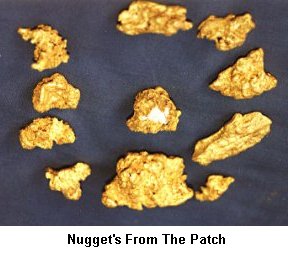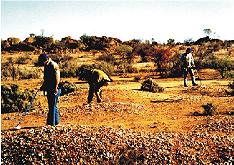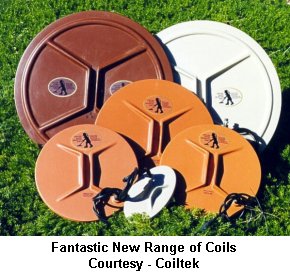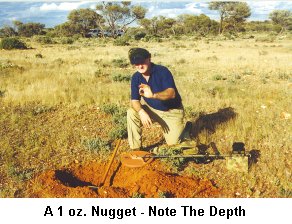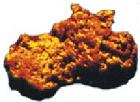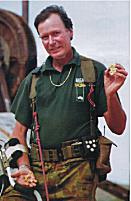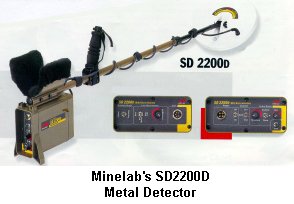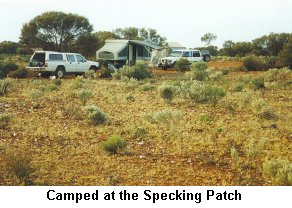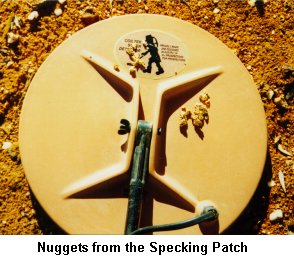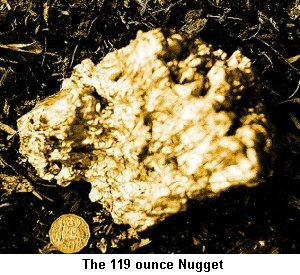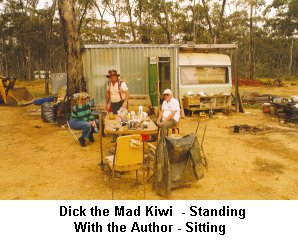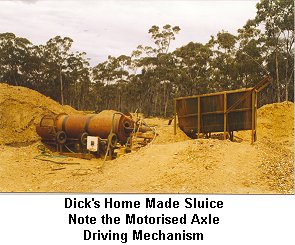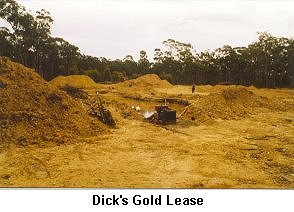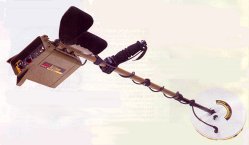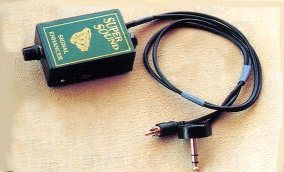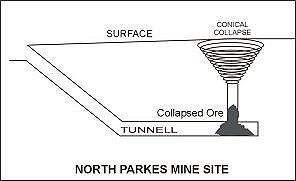
| December1999 | |||||||||||||||||||||||||||||||||||||||||||||||||||||||||||||||||||||||||||||||||||||||||||||||||||||||||||||||||||||||||||||||||||||||||||
|
|||||||||||||||||||||||||||||||||||||||||||||||||||||||||||||||||||||||||||||||||||||||||||||||||||||||||||||||||||||||||||||||||||||||||||
Contents
|
|||||||||||||||||||||||||||||||||||||||||||||||||||||||||||||||||||||||||||||||||||||||||||||||||||||||||||||||||||||||||||||||||||||||||||
| 1. EDITORIAL It is always a pleasure to travel to the Australian gold fields gathering the stories that we bring to you each month. Although it restricts the time we have to gather gold it is still an exhilarating experience to travel the length and breadth of this land, meeting prospectors and sharing information and stories. Some of the characters that are encountered are indeed truly invigorating in their enthusiasm for gold and for this vast land.
Gold Net is therefore pleased to be able to share some of these experiences with you. In introducing our tours we have considered carefully the needs of the international traveller, coupled with a need to provide access to the best gold field sites we can access, while at the same time providing comfortable world class accommodation and services.
After much investigation and thought we believe what we are providing will satisfy the most discerning traveller.
We extend to all our readers - the compliments of the season.
May the joy of Christmas and the peace it brings be shared by all.  Email: [email protected] All material in this magazine is copyright and may not be reproduced in any part or form whatsoever without written permission from the publisher.
|
|||||||||||||||||||||||||||||||||||||||||||||||||||||||||||||||||||||||||||||||||||||||||||||||||||||||||||||||||||||||||||||||||||||||||||
|
2. COBB & CO. IN AUSTRALIA - PART 2 by Craig Wilson When Freeman Cobb sold, he sold to Thomas Davies, another American who was running the People's Telegraph Line of Coaches between Melbourne and Ballarat. The purchase price was reputed to be anything from 7,000 to 16,000 pounds. In any case Davies did not retain ownership of the business for long and he sold it in September 1857 to Alexander Walker, but Walker had difficulty raising the necessary funds and handed it on to George Watson and Cyrus Hewitt, who ran a livery stable in Melbourne. They expanded rapidly and confusion about what they bought and sold at that time is evident. It is known that they bought the Melbourne - Beechworth run from Messrs. Foster and Vines for 7,250 pounds. This was an enormous price for a single run. There were however, 250 horses and 16 or 17 coaches included in the deal. To finance this purchase they sold off other runs, including the Melbourne - Castlemaine - Bendigo run, and the Geelong - Ballarat run to different purchasers. During all these changes the name Cobb & Co was dropped from all official correspondence. However the coaches themselves ironically, kept the name. Blake and Peck, who had bought the Castlemaine - Bendigo run reinstated the Cobb & Co name, in late 1859, when several independent carriers joined forces under the Cobb & Co. banner with their joint offices in Bourke Street, Melbourne. It was from this point that the coaches left Melbourne and a commemorative plaque was installed at this site in 1946.
There were five equal shareholders, with James Rutherford, Wagner, and Robertson holding one share each - with B & C Robertson and Pollock holding one share and Hall and Whitney one. Rutherford was appointed general manager and it was under his control that Cobb & Co. grew into the powerhouse of coach travel across Australia. Rutherford remained in this position for 51 years, even after parts of the company were sold off.
The purchase price was 23,000 pounds with 5,000 pounds being a deposit with the balance being paid over several years. The business prospered so much that within 6 months the entire debt had been repaid. Well at least that is the legend. If that is true it would have been remarkable.
James Rutherford was born at Amhurst, New York State, USA and grew up on the family farm there. He taught school as a young man but eventually found passage to Australia in June 1853 to seek his fortune.
He found the diggings not to his liking and was involved in several small ventures - most of which were not successful. Rutherford continued with horse dealing until 1855 when some friends of his, Watson and Hewitt asked him to find better drivers for their coaches. He engaged some Americans and took over the management of the firm for some months before returning to his previous work. Although being asked to remain in the position, he declined. He took a beating financially in New Zealand when he took sheep and horses there and made a substantial loss on the deal. It was shortly after this that Rutherford and his partners bought Cobb & Co. and set the organisation on its meteoric path to fame and fortune. Among the changes Rutherford brought was to arrange horses by colour, associated with particular drivers. This engendered great pride from the drivers and they were well recognised as being among the best in the land. There were at times 4 horses to a team but 6 was not unusual, and eventually they settled for 5 as a general rule.
Teams travelled about 10 miles in hilly country and about 20 miles on the flats before being changed. Horses were purchased and some were bred on properties owned by the company, to provide large numbers of animals that were required for the ever-increasing coach runs across Australia.
Cobb & Co. had several factories that produced and repaired coaches and were prolific in their manufacture of wheels, which needed regular replacement on their growing numbers of conveyances. In 1876 the railway reached Bathurst from Sydney. One would have thought that this would be the beginning of the end for Cobb & Co. However this was not the case, and the company was to contribute much more to this country and its development.
|
|||||||||||||||||||||||||||||||||||||||||||||||||||||||||||||||||||||||||||||||||||||||||||||||||||||||||||||||||||||||||||||||||||||||||||
|
|||||||||||||||||||||||||||||||||||||||||||||||||||||||||||||||||||||||||||||||||||||||||||||||||||||||||||||||||||||||||||||||||||||||||||
|
|||||||||||||||||||||||||||||||||||||||||||||||||||||||||||||||||||||||||||||||||||||||||||||||||||||||||||||||||||||||||||||||||||||||||||
|
|||||||||||||||||||||||||||||||||||||||||||||||||||||||||||||||||||||||||||||||||||||||||||||||||||||||||||||||||||||||||||||||||||||||||||
|
3. BALZANO THE BARROW MAN by Cheryl Foster During the great gold rushes in Western Australia of the 1890's transport was always a problem. Lucky prospectors had horses, some even had horses and carts, while some clever men utilised camels to cover the vast, arid distances. In a land where water was scarcer than gold most men walked, relying on their own two legs rather than have the trouble of finding water and fodder in a country that had never known the tread hoofs. Relying on just two legs and a strong back limits the amount of food and water one can carry to ensure survival in a hostile land. Enter the Wheelbarrow. With just a single wheel and two shafts the wheel barrow easily tripled the amount of gear a man could transport into the wilderness. It was an ideal mode of transport for the times. It could carry a good load, it didn't bite kick or spit, and it didn't require food or water. Wheelbarrows were pushed from one end of the vast state of Western Australia to the other. This simple device helped to open up huge tracts of gold bearing country much earlier than would otherwise have been possible. Barrows were used to carry supplies of food, water, and equipment out to new goldfields, and carry back the gold. And in a time when epic wheelbarrow journeys were commonplace one man stood out from the crowd. Balzano so captured the imagination of the people of the time his feats are still remembered and celebrated today. Little is known of Balzanos background and he has never been known by any other name.
Another wheelbarrow pushing prospector, Russian Jack, pushed his place into history when he started out in the Kimberly's with his own load. Along the way he picked up the loads of two other distressed prospectors and finished up with a dying man and his swag on top of that. These days Russian Jack would be awarded a medal for such a feat. In those days a simple word of thanks and a hand shake were the most reward any one got, or wanted.
A wheelbarrow such as the one these men pushed can be seen today in the Kalgoorlie Museum. It is made from bush timber, tied together with wire, leather, and rope, it doesn't look as if it would survive a hundred yard dash. Like the men who pushed it, this relic of the glory days gone by is tough and resilient, a simple, silent memorial to the men who were tougher than the land they strode. NUGGET HUNTING POSSIBILITIES Where Balzano, Russian Jack, and all those pioneering prospectors dug gold, they left gold behind. From Norseman in the south of Western Australia to Marble Bar in the north and from Laverton in the east to Broome in the west gold nuggets can be readily found with a metal detector, come try your luck, Balzano did.
|
|||||||||||||||||||||||||||||||||||||||||||||||||||||||||||||||||||||||||||||||||||||||||||||||||||||||||||||||||||||||||||||||||||||||||||
|
|||||||||||||||||||||||||||||||||||||||||||||||||||||||||||||||||||||||||||||||||||||||||||||||||||||||||||||||||||||||||||||||||||||||||||
|
|||||||||||||||||||||||||||||||||||||||||||||||||||||||||||||||||||||||||||||||||||||||||||||||||||||||||||||||||||||||||||||||||||||||||||
|
|||||||||||||||||||||||||||||||||||||||||||||||||||||||||||||||||||||||||||||||||||||||||||||||||||||||||||||||||||||||||||||||||||||||||||
|
4. OLD MEN AND GOLD by Fred Windsor One of the great joys of prospecting in Australia is the camaraderie that exists at all levels, with those involved in finding their share of golden nuggets, or golden flecks. If one travels the length and breadth of this vast country looking for gold, you will invariably come across the most charismatic and endearing characters that share this wonderful past time. Perhaps the most endearing are the old men who traverse these tracks in search of gold. To meet with and enjoy the campfire stories with some of these old gentlemen is one of the great joys and pleasures of life. The wealth of life's experiences that rests within these characters is inestimable. From retired solicitors, farmers, politicians, bankers, engineers, nurses, policeman, soldiers and such like, the list could be endless, comes a desire to live life to the fullest, and not vegetate in the twilight years of their lives. It must be said most of these fascinating characters are indeed living their lives with great gusto and meaning. To sit around a campfire and listen to some of their experiences is an exhilarating and, at the very least, an enormous learning experience. Whatever subject is broached undoubtable someone present will have a good knowledge of the subject and will willingly partake of this knowledge.
Some of these characters are well known around the gold fields. Year after year they visit the same parks in search of their gold, and share their experiences. I do not intend to single out anyone in particular, but there are a couple of old blokes that hail from Adelaide and are often seen in the gold fields of Victoria. They have no favourite spots, but they certainly cover some ground while they are in the golden triangle. I saw them at Ararat one day and at Wedderburn the next day. I might add that getting to know these two characters, is quite an experience. One of them professes to be an expert in everything and the other knows everything and is an expert in all things. Well they will tell you that anyway.
They are a great couple together and tend to amicable disagree on every subject that is discussed. To sit around a campfire and listen to them disagree and amicably argue the point brings a grin to all that are present. I have found that the further away one goes from civilisation, the friendlier people become. Perhaps it's the isolation and the human need to congregate, or maybe it's just the necessity to gain as much support as you can in remote areas, but you do find some outstanding characters "out there". I remember the time I was half way between Laverton and Wiluna on a very old and little used track and was caught in an unseasonable downpour, and within minutes I was bogged.
Luckily this bloke knew what he was about and had a long rope for just such an occurrence. Within minutes I had been winched out. We camped together for the next couple of nights. I enjoyed the company, and John and his wife Margaret are now among my most treasured friends. They had a newsagency down along the beach suburbs of Melbourne and during the winter spent a lot of time in the western Australian gold fields. I don't mind admitting I was mighty glad to see that old bloke let me tell you.
Well the gold fields are an alluring place and a magnet for older people who have retired from their usual paying jobs in life, but still want to "live" life to the fullest. Throughout the winter months the caravan parks in the Golden West are practically full of these charming and wonderful characters. Perhaps most are not expert bushman, but they are intelligent people who learn quickly and develop a deep love of the life style. The fabulous camaraderie that is obvious to all is nurtured and cherished by all those old blokes and their partners, who travel this path in the latter stages of their lives. |
|||||||||||||||||||||||||||||||||||||||||||||||||||||||||||||||||||||||||||||||||||||||||||||||||||||||||||||||||||||||||||||||||||||||||||
|
|||||||||||||||||||||||||||||||||||||||||||||||||||||||||||||||||||||||||||||||||||||||||||||||||||||||||||||||||||||||||||||||||||||||||||
|
|||||||||||||||||||||||||||||||||||||||||||||||||||||||||||||||||||||||||||||||||||||||||||||||||||||||||||||||||||||||||||||||||||||||||||
|
|||||||||||||||||||||||||||||||||||||||||||||||||||||||||||||||||||||||||||||||||||||||||||||||||||||||||||||||||||||||||||||||||||||||||||
|
5. WHERE AND HOW TO FIND GOLD IN AUSTRALIA by John Gladdis Just where is the gold in Australia? Is it there in the quantities claimed? Can it be recovered by the privateer? These are all questions that are regularly asked and to a degree answered. The most obvious answer comes in the fact that Australia produces about 300 tons of gold each year from a broad area of auriferous ground. This area stretches from huge areas in the deserts of Western Australia to the tropics of North Queensland, in the northwest, and the golden Triangle of Victoria. Perhaps the greatest gold field in the world was the Victorian Golden Triangle. It most certainly was "nugget paradise" unmatched on a global scale. The largest nuggets in the world come from this fabulously rich area. Although a good portion of the surface gold was taken from this ground 150 years ago there is still a lot of gold locked in this ground. Technology, in recent years has reaped a rich reward from this area, with some massive nuggets being recovered in the last 20 years or so. As recently as last month a 1,200-ounce specimen nugget was located at Stuart Mill, south of St. Arnaud, and a 119-ounce nugget was found at Bendigo. (See Strikes) in this issue. These are by no means isolated finds, as many nuggets are still being found in this area.
One will find that in this country there is still some virgin ground yet to have a detector over it. It is clearly this ground that is producing the best nuggets these days. Although one does hear of "thrashed" ground being detected with the latest technologies still producing good deep nuggets. The greatest asset that the privateer has is that the local Historical Societies have, to a degree preserved all the historical records that reveal much about where the most gold was recovered in the old days. Government records still kept in archives are a wealth of knowledge, and in general pinpoint the exact locations of gold finds. Most professional prospectors using detectors spend up to 80 per cent of their time researching and 20 percent recovering the gold as a result of their research. Most detector operators just wander around over the vast areas, while the real pro will research and then head directly to the area and detect with the most appropriate detector coil for the area. This information can be gleaned from extensive research, which in the main will reveal not just the area, but the depth, and the quantities taken from the area. Some areas in the Golden Triangle are still giving up some very large nuggets from areas that 150 years ago produced copious quantities of gold. The great value of operating in this area is that the entire district has good infrastructure to support the prospector. Good motels, hotels, caravan parks and repair facilities exist and are usually within a few miles. Additionally it is contained in a relatively small area and is easily accessible. It should be noted that panning in this area is minimal. This is a predominantly a nugget area, and although some areas exist where panning can be undertaken, it is not a rewarding experience in general.
The best areas are located round Kalgoorlie, Leonora and Laverton, where vast auriferous plains hide a wealth of gold. In this region there are reasonable facilities, but it should be remembered, this is still frontier country, with facilities somewhat limited. In the Pilbara, the area is both vast and forbidding. Except for a few coastal communities, station homesteads and mining camps, you are essentially on your own. Four wheel drive country all the way and very remote. One would never enter this country without support of some sort. Be it another four-wheel drive vehicle or back up from an arranged source if required. I wouldn't go into this area without a satellite phone, and the best equipment available to provide "self help".
On the other hand the rewards here in this vast land can be fantastic. I heard of one couple reaping about $200,000 worth of nuggets in a two-month bonanza using the very latest Coiltek coils, on their Minelab 2200d's.
The main regions, where gold is sought by the privateer is certainly the Golden Triangle of Victoria and the Kalgoorlie Region of Western Australia. There is still good gold in both these areas and remains an attraction to the privateer. It is estimated that there is still enough surface gold to keep the privateers occupied for another 20 years, at least.
|
|||||||||||||||||||||||||||||||||||||||||||||||||||||||||||||||||||||||||||||||||||||||||||||||||||||||||||||||||||||||||||||||||||||||||||
|
|||||||||||||||||||||||||||||||||||||||||||||||||||||||||||||||||||||||||||||||||||||||||||||||||||||||||||||||||||||||||||||||||||||||||||
|
6. GOLD DOES STRANGE THINGS TO PEOPLE by Les Lowe
After prospecting for 15 years and studying those around me who follow a similar way of life I've arrived at the conclusion that gold does have some strange effects on people. It can turn strangers into mates and lifelong mates into enemies for eternity. I was way out the very edge of the Eastern Goldfields of W.A., north east of Laverton, almost into the desert and a long way away from anywhere, with some beginners and an aboriginal friend of mine of long standing. He's a full blood Yamatji by the name of Georgie Simpson -an excellent bushman and one of the best detector operators that I have ever encountered. George likes his gold but it doesn't do strange things to him, like greed and jealousy. His blood's worth bottling. We share our knowledge about patches and even though he's taught me a lot about the bush, he's forgotten more than I'll ever know. Anyway, George and I had been out there about four days slowly working our way up this strike line - a few pieces here, a few pieces there and the tally is slowly going up. We were getting close to an area that produced 750 ounces about ten years ago with Minelab 16000s from a gully the size of a small footy oval. It was later bulldozed and produced another load of similar weight. It was a "tight" patch when it was first found. No, it wasn't me that got that lot - but I do know who did get it.
So I says "Ok. I'll keep my eye on these "tourists", see ya in a couple of days, mate." Just before he leaves, George says to me, "Les, a couple of months ago, I picked up a nice ten gram piece just down by the track". I says, "EXACTLY where, George? We've done most of this paddock and there's not much of it left." He says "Aahh, just down there, mate, near my old campfire," and he points down the slope towards the track. Off George goes, back to Laverton. I wander down to find "his old campfire". I find the campfire and start "bipping" right on the edge of the track. The ground is quiet, unusual for this neck of the woods. A pleasant 20 minutes just cruising along on one of those cool sunny mornings where the whole bush seems that bit brighter and that much quieter than normal, quiet as the grave, when "WHUUUUMMMMP" in the headphones - "what the - What was that?" A quick look around - no rubbish around here, too far beyond the black stump out here. Scrape with the pick, listen, WHHHUUUUMMMPPPP! - louder this time, this is it. Scrape again - too hard, use the other end of the pick stupid, the SHARP END. Smash, smash - listen again - WWHUUUMMPPPPPPP. This is definitely IT. By now I'm down about 20 inches and the old 2000 is going WHUUUMMMPPPPP, WHUUMPPPPPPP. Smash, dig, scrape, smash, scrape - finger nails getting torn off. I shouts out to one of the "tag-alongs" up at camp drinking tea (as usual) - "Oswald, bring the big pick and a big shovel." "Ossie" arrives tools in one hand, cup of tea in the other, "Have you got something there" he says in a voice reminiscent of someone whose body is in this world but his brain is in another.
It was getting on dark, so I started to foot chain the area. Another one ounce piece near the track and I couldn't see a thing, so it was back up the hill for a beer, some dinner and sleep. First thing next morning and I'm into it. "Fill yer boots, Les". All day it went on - one ouncer, two ouncer, half ouncer (throw it back until it gets bigger?, nahh, don't be stupid, Les), three ouncer - no small bits here thank you very much. At lunch time I sat down for a break and a bite to eat. "Ossie" asked me could he use my 2000 for half an hour. He'd been doing this for about three weeks every time I took a break and had accumulated about three ounces. One big specimen and two small bits, with my machine. We had a deal that any one piece over an ounce, then he paid me 50% of it or the equivalent in other gold. He only had an old ML17000 and no money but was useful for digging deep nuggets and "lifting heavy things" - he was a big lad. About ten minutes later, he's back, running up the hill to camp screaming "Les, Les, Les", but out of breath at the same time. "Look at this". He dropped into my hand what I reckon was the best looking piece of gold I have ever seen. It was about 2.5 ounces in the perfectly symmetrical shape of a butterfly. Flat with a long body, one set of small wings, one set of big wings (but no antennae, obviously). It was really beautiful, and of course it was that rare occasion that I didn't have a camera. Ossie says, "Les, I can't pay you for this. I haven't got a brass cracker to my name" (and he already owed me $400.00 to keep him going this far). "We'll have to cut it in two," he says. "No way," says I. "That is the most exquisite nugget I have ever seen - no way - keep it with my compliments". I still can't believe I actually said that and my wife has never forgiven me for saying it. "Tea break over, back on yer heads," shouts I, and I'm back down the hill. It's on again - one ounce, half an ounce etc, etc, etc. The following day, George comes back. "How ya going, Les, get much?" he asks in his usual slow, dry manner. I says, "George, brace yourself son, you've got a shock coming" I took him back to the camp and threw the plastic box into his hand - he dropped it. The top fell off the box and out it came, all 66 ounces. "Where did ya get this lot?" he says. "Down there near your old campfire." "Where?" he says, "come and show me."
WRONG CAMPFIRE. Readers, you may be stunned - I wasn't - that's just George. Anyway, to make things up a bit I later paid off the loan on his SD2000 and that was almost that. "Ossie, the tourist," shot through the next day back to Laverton, saying he'd send me the money that he owed me and off he went. About three weeks later I'm back in Laverton looking for "Ossie" and my $400.00 and 50% of "The Butterfly Nugget". The caravan park owner said that "Ossie" had got his NEW SD2000 and was going back to some patches that "an aboriginal mate and a white bloke had shown him" -AND I HAVEN'T SEEN OR HEARD FROM "OSSIE" SINCE.
Isn't it amazing what gold does to some people and what it doesn't do to
Others? The name of the tourist has been changed to protect the guilty.
|
|||||||||||||||||||||||||||||||||||||||||||||||||||||||||||||||||||||||||||||||||||||||||||||||||||||||||||||||||||||||||||||||||||||||||||
|
|||||||||||||||||||||||||||||||||||||||||||||||||||||||||||||||||||||||||||||||||||||||||||||||||||||||||||||||||||||||||||||||||||||||||||
|
|||||||||||||||||||||||||||||||||||||||||||||||||||||||||||||||||||||||||||||||||||||||||||||||||||||||||||||||||||||||||||||||||||||||||||
|
7. GOLD BY THE TON by Jim Foster
Official industry figures show metal detector operators and small prospectors sold about eight tons of gold worth over A$120,000,000 to smelting companies in Australia in 1996/97. That is not counting all those nuggets that people keep rather than sell. In fact, very few amateur detector operators sell their gold. BUY AUSTRALIAN MADE When I bought my first detector back in 1979 I choose to buy the best machine available, a Garrett Deepseeker from the U.S. It cost me an arm and a leg but I never regretted it. I saw plenty of others buy cheaper machines and the trouble they had. But things have changed in the gold detector industry. During the 1970's and early 80's America ruled the roost. Millions of dollars poured out of Australia to pay for the thousands of imported detectors. Today the tide has turned. Australian technology applied to gold detectors means we now lead the field by an outback mile. Choosing a good gold detector depends on many things. How serious are you about finding gold? How much can you afford? Buying a gold detector is like buying Off Road gear for your RV. You buy the best your budget will stand. JOIN A CLUB Joining a detecting club is always a good idea. Go on a couple of outings and watch what the best performers are using and how they use their detectors. Listen to what they say. Most clubs will organise for you to borrow a detector so you can join in. The best detector on the market today is the Australian made Minelab SD2000D. Rec. retail is Australian $4,200.00. This might seem like a lot of money but you will get a detector easily four times better than its nearest competitor.
CONVENTIONAL DETECTORS Conventional detectors, those other than the SD range, have also made big improvements. The XT18000 gold detector is the latest of the Auto Ground Tracking style detectors on the market. Auto ground tracking means you don't have to continually tune the detector to varying ground mineral conditions. It also has three different search wavelengths, something no other machine has. The XT18000 will find gold from pin-head size crumbs of gold just under the surface to larger deeper nuggets. This is an easy to use detector that won't have you kicking it into the bushes with frustration. ( I know, I've done just that ). If I couldn't stretch my budget to the SD2200D, I wouldn't buy less than the XT18000.
SECONDHAND DETECTORS
Be careful when buying second hand detectors. Should you buy a stolen detector and it has to be serviced, it will be seized. Then you'll have the pleasure of a visit from some very polite men wearing suites.
|
|||||||||||||||||||||||||||||||||||||||||||||||||||||||||||||||||||||||||||||||||||||||||||||||||||||||||||||||||||||||||||||||||||||||||||
|
|||||||||||||||||||||||||||||||||||||||||||||||||||||||||||||||||||||||||||||||||||||||||||||||||||||||||||||||||||||||||||||||||||||||||||
|
|||||||||||||||||||||||||||||||||||||||||||||||||||||||||||||||||||||||||||||||||||||||||||||||||||||||||||||||||||||||||||||||||||||||||||
|
|||||||||||||||||||||||||||||||||||||||||||||||||||||||||||||||||||||||||||||||||||||||||||||||||||||||||||||||||||||||||||||||||||||||||||
8. FLECKS ! - Glints from here and there
|
|||||||||||||||||||||||||||||||||||||||||||||||||||||||||||||||||||||||||||||||||||||||||||||||||||||||||||||||||||||||||||||||||||||||||||
|
|||||||||||||||||||||||||||||||||||||||||||||||||||||||||||||||||||||||||||||||||||||||||||||||||||||||||||||||||||||||||||||||||||||||||||
|
9. MINELAB - TO THE WORLD by Ray Groom
Commencing operations in 1987 Minelab has developed into a unique and prosperous company. In the early 1980's a mini boom in gold recovery began in Australia, when it was realised that the old gold fields still contained an enormous amount of gold. Most gold detectors were being imported from the United States - but it was quickly realised that these had not been developed for the unique conditions that existed in Australia. Consequently in 1987 Minelab commenced and shortly after released the GT 16000 Ground Tracker. The first detector produced with a microprocessor driving it. It was in instant success. Minelab was established as a force in metal detecting. The advantage Minelab had was that it developed a Broad Band Spectrum (BBS). It is radically different in that the detector used 17 different frequencies simultaneously rather than the single frequency used by competitors. From that time - Minelab research and development has been extensive and as a result they have developed the worlds most sophisticated detectors by a country mile. With this new technology, the company released the 2000 SD (Super Detector) It is anticipated that during this time over A$100,000,000 worth of gold was recovered using this technology over the following decade. We might say that this is a conservative estimate, as a lot of gold that is recovered is kept by the finder and is consequently unrecorded.
With the development of the SD 2100, which was a "smash hit", a great deal more gold was being wrenched from the dirt of gold fields all over Australia.
The depth of this detector and its legendary capacities literally created a new business boom all over Australia. Many hobby prospectors turned into full time professionals. Incredibly this phenomena has continued to the present day with about 2-300 full time detector prospectors still operating in Australia.
1998 was an extremely busy year for Minelab.
As a final accolade to 1998 the company won the prestigious, "Most Innovative Company" and the overall "South Australian Business Award for 1998"
In 1999 the company developed an off shore office in the Republic of Ireland, and has now developed a factory there, which will manufacture and distribute throughout the European and North American Markets. It should be recognised that this company is proudly Australian and there is no intention to relocate off shore. The headquarters will remain in Australia as the controlling Board of Directors have indicated strongly that relocating management off shore is not under consideration at all. Expansion is certainly under consideration and further developments are planned in that area. In recent times the company has become involved in developing military detectors, and sales have been made to UN forces to remove mines of all types, including anti-personal and anti tank devices from the worlds trouble spots. This is seen as a developing direction for the company.
In the research and development department the company is clearly developing other products. I am not privy to all of these - but it would be fair to say that there are some exciting developments for the new millennium. Minelab's web site can be seen at www.minelab.com.au Minelab has been an outstanding success in Australia, and will be - to the world. Contact details for Minelab World wide are as follows.
|
|||||||||||||||||||||||||||||||||||||||||||||||||||||||||||||||||||||||||||||||||||||||||||||||||||||||||||||||||||||||||||||||||||||||||||
|
WE BUY GOLD GOOD QUALITY NUGGETS REQUIRED TOP PRICES PAID Currently seeking nuggets from 6 grams upwards. Gold nuggets sold on consignment 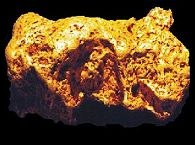
PO Box 533, KENT TOWN 5071 Mobile: 0417 848 910 E-mail: [email protected] |
|||||||||||||||||||||||||||||||||||||||||||||||||||||||||||||||||||||||||||||||||||||||||||||||||||||||||||||||||||||||||||||||||||||||||||
|
|||||||||||||||||||||||||||||||||||||||||||||||||||||||||||||||||||||||||||||||||||||||||||||||||||||||||||||||||||||||||||||||||||||||||||
|
10. SPECKING FOR GOLD by Graham Smyth Specking for gold, or just finding gold by eyesight is the easiest way to find gold. Specking is mostly done on ground where the old timers did a lot of the work for us. We can find gold that the old timers dug many metres into the iron-hard ground for, and missed. They weren't interested in specking. Their idea of specking was lumps big enough to go clang on their shovel. WHERE TO LOOK Gold can be specked on just about any old goldfield. The best places are the richest spots on the diggings. This is where the mullock heaps are the most concentrated. The richer the diggings the more chance the old timers threw away lots of gold. Surfaced, or paddocked ground, usually found at the head of a gold bearing gully or on the sides of a "hard hill" are also very good ground. Surfaced ground can easily be seen. Here the shallow gold bearing ground was stripped away down to the red clay.
Not all specking is done on old diggings. At Tibooburra in the far north west of New South Wales, Australia, gold can be specked in the main street after a good rain. One lady specked 180 tiny gold nuggets on the town water catchment area in one afternoon after last years summer rains. Similar spots can be found in other gold areas but especially in dry outback regions. MAPS Finding a goldfield near you is easy. Goldfield maps are available from any fossicking or prospector supply shop. These will get you on the gold diggings. For those who are more map minded more detailed maps are also available. Some maps even show where big nuggets were found, usually the richest point in any goldfield. EQUIPMENT Very little equipment is required for specking. There are things that will make life easier while finding that elusive yellow stuff. A bit of carpet, preferably foam backed, or an old rug will do to kneel on. Goldfield ground is hard as concrete with small sharp pebbles all over it. To concentrate you must be comfortable. An empty plastic film container is best to put your gold in. A glass bottle shows your finds better but will shatter if dropped. A pair of plastic tweezers will enable you to pick up even the tiniest bit of gold. A magnifying glass will enable you to see very small gold or the edge of an almost buried piece. Polarising sunglasses take the glare off shards of quartz and other shiny stones while enabling you to pick out the gold.
SHOWING OFF YOUR GOLD Once you have found some gold you need somewhere to keep it. A small clear glass bottle is good. Place a bit of green electrical tape along one side of the bottle to contrast the gold. Fill the bottle with clean water and transfer the gold into it. With the gold inside submerge the bottle in clean water before screwing on the cap. This will keep any air from the bottle allowing easy viewing of the gold while the natural curve of the bottle will enlarge the gold to impressive proportions. Good viewing bottles can be obtained from your local fossicking shop.
Specking for gold is easy, it can be enjoyed by the entire family and it costs very little. Through travel and research it will enhance you and your families appreciation of our turbulent and colourful history and pay you a bonus of your very own original and unique gold jewellery.
|
|||||||||||||||||||||||||||||||||||||||||||||||||||||||||||||||||||||||||||||||||||||||||||||||||||||||||||||||||||||||||||||||||||||||||||
|
|||||||||||||||||||||||||||||||||||||||||||||||||||||||||||||||||||||||||||||||||||||||||||||||||||||||||||||||||||||||||||||||||||||||||||
|
|||||||||||||||||||||||||||||||||||||||||||||||||||||||||||||||||||||||||||||||||||||||||||||||||||||||||||||||||||||||||||||||||||||||||||
|
|||||||||||||||||||||||||||||||||||||||||||||||||||||||||||||||||||||||||||||||||||||||||||||||||||||||||||||||||||||||||||||||||||||||||||
|
11. STRIKES Recent Finds
|
|||||||||||||||||||||||||||||||||||||||||||||||||||||||||||||||||||||||||||||||||||||||||||||||||||||||||||||||||||||||||||||||||||||||||||
|
|||||||||||||||||||||||||||||||||||||||||||||||||||||||||||||||||||||||||||||||||||||||||||||||||||||||||||||||||||||||||||||||||||||||||||
|
|||||||||||||||||||||||||||||||||||||||||||||||||||||||||||||||||||||||||||||||||||||||||||||||||||||||||||||||||||||||||||||||||||||||||||
|
|||||||||||||||||||||||||||||||||||||||||||||||||||||||||||||||||||||||||||||||||||||||||||||||||||||||||||||||||||||||||||||||||||||||||||
|
12. DICK THE MAD KIWI by Laurelle Murphy Dick Nicolson is mad. At least that's what he will tell you. Just let me tell you - perhaps sometimes you think he just might be right. He is indeed an endearing character, and makes an impact on all he meets. Now although some in Aus. may claim him as one of their own, he is in fact a Kiwi. (A Kiwi, being a native of New Zealand). But here in Aus. we will forgive him that small indiscretion of being born across the Tasman Sea. Fancy not being born here. Well at least he IS domiciled here, and we are glad to have him. Dick came to Aus. about 5 years ago seeking his fortune, and eventually settled in Tarnagulla, Central Victoria, right in the middle of the Golden Triangle, where the gold was so prolific. He bought a small cottage or two on a large block at one end of town and then set out to find some gold.
He found his gold at the other end of Tarnagulla in a small lease that he operates. Now while I was at the Gold Panning Championships, Dick invited me, along with just about everyone else he talked to, to visit his claim and have a cuppa. Dutifully I made my way there on the Monday morning along with a large assortment of others that had also been invited. The lease he operates is just outside Tarnagulla, and there is an assortment of old vehicles, some that are broken down and others that look broken down but are the main operating machines on the lease. Just as the old timers sluiced gold here 150 years ago - Dick and his crew are doing the same here now - but using mechanisation to do it. Well should I qualify that by saying mechanisation of sorts. There is a variety of machines that have been developed on a shoe string budget, with some very inventive thought put into some of the contraptions, and I couldn't really describe some of them in any other way. Necessity is the mother of invention, so they say.
The lease has a small dam, and another forward water point has been dug near where the sluicing is being undertaken at the moment. Water is scarce and is re-cycled as often as possible.
When he offered us a "cuppa", and we accepted it was necessary to start a fire on the ground near his camp. This was quickly lit and a "billy" full of water placed on the fire in a traditional style. Now while this was happening we had an assortment of events occurring. Dick had one fellow "divining" for gold - and the two novices sluicing at the dam's edge. Someone else was using a metal detector across the old creek, and the caretaker, who was resident in a caravan nearby, was invited to join us. His role was to organise the brew. Someone else went in a ute for something else and, the two guests from the US, were detecting in a gold rich area.
While this was going on I took the opportunity to "try" and interview Dick.
Now Dick told me a few home truths while I was talking to him.
Before I could get a question out, he asked it I could solve a puzzle for him.
Well at least I would try. He took my hand and opened up the palm explaining, as he stroked the palm that this was water and we had to cross the water. The water was full of piranhas and there was no bridge. He kept stroking my hand as I tried to work out a way to cross. Eventually he let me off by saying that in fact there was no way across, but it was good stroking your hand. The grin was broader this time. Dick told me that he had not always been successful in business and the best idea he ever had was curtained by Air New Zealand. In his way he described that he wanted to go to the south island of New Zealand where the snow was plentiful, arrange a giant sling shot and shoot the snow over to Australia to solve the lack of water problem. The airline had seemed to think it would interfere with air traffic or something so that idea was shelved. Dick is full of anecdotes like that. It is part of his make up. He told me about a good investment he made. He bought a water tanker to cart water to the dam to supplement the water supply. The tanker so cheap that he was sure he had the bargain of a lifetime, except for one thing. The tanker leaked life a sieve, and by the time he got from the supply to the dam, about half a mile away all the water had drained out. Well at least it kept the dust down on the road into the site, so it wasn't a total waste.
That seems to be the story of Dick's life. A likeable, but cheeky character that one sometimes finds in the Australian bush, that are warm and endearing to all. I wanted to talk longer but time was getting away and when Tom from Texas arrived back in camp with a nice little 2 or 3-gram nugget, and tried to pay Dick for it. He politely declined the offer, as we all knew he would. These days Dick only works about 2-3 days a week - just enough to make enough to live and enjoy the bush life he has come to enjoy. I will visit again Dick and I will not be so easily tricked with your charm the next time I visit.
|
|||||||||||||||||||||||||||||||||||||||||||||||||||||||||||||||||||||||||||||||||||||||||||||||||||||||||||||||||||||||||||||||||||||||||||
|
|||||||||||||||||||||||||||||||||||||||||||||||||||||||||||||||||||||||||||||||||||||||||||||||||||||||||||||||||||||||||||||||||||||||||||
|
|||||||||||||||||||||||||||||||||||||||||||||||||||||||||||||||||||||||||||||||||||||||||||||||||||||||||||||||||||||||||||||||||||||||||||
|
|||||||||||||||||||||||||||||||||||||||||||||||||||||||||||||||||||||||||||||||||||||||||||||||||||||||||||||||||||||||||||||||||||||||||||
|
13. THE NORTH PARKES MINE DISASTER by Jim Foster The North Parkes Gold and Copper mine lies some 20 miles north west of Parkes, in Central New South Wales. It is owned by North Limited and boasts some of the most sophisticated gold recovery equipment and methodology in the world today and had been successfully operating for about 6 years. The mine employed 180. Some say that the ore recovery method is revolutionary, while others say it is fraught with danger and is untried. Whatever your opinion, what occurred on the 24th of November 1999 will certainly change the face of Parkes and the North Parkes Mine forever. The methodology used to recover the ore bodies from the mine is controversial. It is mined from below and tunnels are dug under the ore body and the ore is collapsed down into the tunnels and extracted. It was thought to be a safe method of recovering ore, in that it requires very few men underground at any one time. The mine usually has only 8 men underground when operating, with an almost fully automated facility. On Wednesday the 24th it was a warm morning at Parkes. Wednesday had been set aside at the North Parkes Mines for below ground maintenance. Mining operations were silent as the 61 men, some employed by North Ltd. and some private contractors entered the mine that morning, most in teams of 3 or 4 to undertake their regular maintenance duties.
At the end of the main tunnel the main ore extraction facility was silent, but the ore was sitting precariously over the main tunnel from where it was being mined ever upward toward the surface. What was not known was that this ore body was about to collapse into the main tunnel. Two men were working immediately under the ore body and another two were approaching that area in a motor vehicle. Without warning the ore body collapsed downward into the tunnel, killing and burying instantly the two men working there. The gravitational force of the collapsing ore created a massive shock wave of compressed air that hit the vehicle with such force that the car exploded and disintegrated, killing the two occupants instantly. The massive dust cloud that erupted belched towards the entrance covering men as they ran from the mine to safety.
An enormous rush of air reached the mine entrance and dust and debris escaped into the open surrounds of the mine.
The surface above the diggings displayed a conical collapse downwards.
A massive amount of ore in the millions of tons had collapsed into the mine. Parkes is a rural town and a town where neighbours know each other. It is a close knit community and as the alarm was raised the rescue services very quickly made their way to the mine. The mine rescue teams quickly went into action and the well drilled and trained teams secured the area and began clearing access to the mine. Two days later the mine had not been fully stabilised, and efforts continued for another two days before the ventilation shafts were restored and the bodies recovered.
Disasters of this nature are unfortunately sometimes a by product of mining and although safety is a major concern, and worlds best practices put in place the nature of the industry dictates that at times, some tragedies will occur. This accident is being fully investigated by the following departments. The Department of Mineral Resources, New South Wales. The State Coroner is undertaking an independent investigation and the New South Wales Police Department. North Parkes Mine management and staff are fully co-operating with these investigations. The mining activities of North Ltd can be viewed on the Internet at: www.north.com.au We extend to the families of the following our deepest sympathy in their tragic loss.
Michael House Stuart Osmond Colin Lloyd-Jones
|
|||||||||||||||||||||||||||||||||||||||||||||||||||||||||||||||||||||||||||||||||||||||||||||||||||||||||||||||||||||||||||||||||||||||||||
|
|||||||||||||||||||||||||||||||||||||||||||||||||||||||||||||||||||||||||||||||||||||||||||||||||||||||||||||||||||||||||||||||||||||||||||
|
|||||||||||||||||||||||||||||||||||||||||||||||||||||||||||||||||||||||||||||||||||||||||||||||||||||||||||||||||||||||||||||||||||||||||||
|
|||||||||||||||||||||||||||||||||||||||||||||||||||||||||||||||||||||||||||||||||||||||||||||||||||||||||||||||||||||||||||||||||||||||||||
|
14. PATCHES OF GOLD by Jim Foster Most electronic prospector's dream of finding undiscovered patches of gold nuggets. The one state of Australia where this dream can come true is Western Australia. Not that other states don't have patches, they do, but far fewer and mostly smaller patches. One of the reasons for this is that Victoria, for example, has most of its goldfields in hilly country where the gullies are steep sided and narrow. This means most of the gold is concentrated in the bottom of the gullies, where it was easier for the old timers to find it and mine it. A RARE DREAM My wife, Cheryl, and I had found small patches in Victoria and in the far north west goldfields of New South Wales, but none of these patches had produced anything that could be weighed in ounces. A few small nuggets weighing a total of several grams can be exciting at the time but don't do much for the bank balance. Then, twenty years after I'd begun detecting, we finally got to where the patches are. Western Australia's Eastern Goldfields are where most eastern state folk go to prospect for the winter. The weather is mostly fine, warm, and sunny and the gold is everywhere. Despite that, this country has had detectors waved over it for the last twenty-five years, but there are still plenty of patches to be found. It is easily accessible. From the gold country capital, Kalgoorlie it is only two hundred and thirty kilometres north along a sealed road to the heart of the goldfields, Leonora. In the centre of the eastern goldfields Leonora exists as a mining town and centre for supplying the yearly influx or tourist-prospectors. PATCH COUNTRY The country making up the WA Eastern Goldfields is mostly flat. Small hills and ranges dot the countryside but the country in between is flat, or with an almost imperceptible fall. Patches of nuggets can be found on the gently sloping sides of hills or out on the flats. They can be found on top of the hills or in the creeks, below quartz reefs can also be rich, and despite all those years of being searched it is common to find patches within patches. That is, areas that have yielded many nuggets in the past will often yield many more to the more modern detectors of today. OUR FIRST PATCH It is common for people to walk right through a patch and never find it. One patch in Victoria was between two gullies. Many people, including ourselves had walked across that patch over a period of nearly twenty years. But the patch was there and with the advent of the SD series of detectors it was found, but unfortunately not by us. The patch contained 80 nuggets with the biggest weighing two and a half ounces and covered less than an acre. In WA it was much the same. We found a spot where nuggets had been found since 1980. There were old detector holes dotted across the slope in every direction. It was the slope leading up to a rich reef where a great deal of gold had been won late last century. Old campfires could be found in every patch of trees, proof that many people had spent considerable time detecting the area in recent years. These days we have better detectors. We were using the latest detectors, the Minelab SD2200D, fitted with the latest search coils from Coiltek. We also used audio boosters and with this equipment we found our first decent patch of gold.
LONELY NUGGETS To find a patch, especially on new ground, a lot of walking must be done. In doing this you will search likely looking ground and only find stray nuggets. These are nuggets out by themselves with no other gold for miles around. Somehow it is possible to walk onto a single nugget in many acres of ground and find, after hours of searching, that it was the only one there. It sounds impossible but is in fact quite common. This happened to us more often than we wanted, but a nugget is a nugget and even if it is the only one for the day it means you did get something. NEW PATCHES While it is fun digging gold on any ground it is the most exciting digging nuggets on ground where no one else has ever found gold. This can happen anywhere. The first new patch we found was beside a creek crossing. Every year hundreds of prospectors drove right through the middle of that patch. A recent camp was only fifty yards from it and they hadd missed it. We drove through it five times ourselves before I finally stopped and had a look at what I thought looked like good ground. The first nugget turned up after only a few minutes work, a nice little two grammer. Studying the ground I worked out where I reckoned the gold would be and concentrated on that area. A pattern soon emerged and I found the source of the gold. From then on it was easy.
OUR BEST PATCH This wasn't the biggest patch but it was the most fun. Moving to a new camp I found the first nugget only twenty feet from camp. Searching hard both of us moved out from the camp but could find no more. Seeing better looking ground further out we both headed in different directions. After two hours of finding nothing, the memory of that first nugget drew me back to camp, but too late. Cheryl was already there and on a patch. When we'd moved out further we'd passed either side of the patch and missed it. Cheryl, being first on it had first go at the gold so I left her to it. When Cheryl had recovered most of the gold I moved in with a bigger search coil and cleaned up the smaller, deeper gold that she had missed with her smaller coil. Over about eight hours we found nearly forty nuggets weighing nearly two ounces on that little patch. The gold began thirty yards up the slope and extended down slope under our camp. Cheryl found the biggest nugget under the ute. ANYONE CAN DO IT All of our gold came from country that has been searched for over twenty years. Patches of gold can still be found in the same area and will continue to be found for many years to come. All it takes is patience, the best equipment available, and a sense of fun and adventure. We were never further than a hundred kilometres from Leonora in country easily accessible by four-wheel drive and accessible in two wheel drive vehicles with care. We camped out on the gold but many people prefer to camp in the Leonora Caravan Park and drive out each day. This works, but you'll find more gold if you camp out ORGANISED EXPEDITIONS For your first trip to Western Australia it is best to go with someone who knows the country. If you don't have a friend to go with, consider an organised tour, that way you learn the country and can continue after the tour on your own.
|
|||||||||||||||||||||||||||||||||||||||||||||||||||||||||||||||||||||||||||||||||||||||||||||||||||||||||||||||||||||||||||||||||||||||||||
|
|||||||||||||||||||||||||||||||||||||||||||||||||||||||||||||||||||||||||||||||||||||||||||||||||||||||||||||||||||||||||||||||||||||||||||
|
15. THE NEW LODE - Next Month's Issue
|
|||||||||||||||||||||||||||||||||||||||||||||||||||||||||||||||||||||||||||||||||||||||||||||||||||||||||||||||||||||||||||||||||||||||||||
|
|||||||||||||||||||||||||||||||||||||||||||||||||||||||||||||||||||||||||||||||||||||||||||||||||||||||||||||||||||||||||||||||||||||||||||
